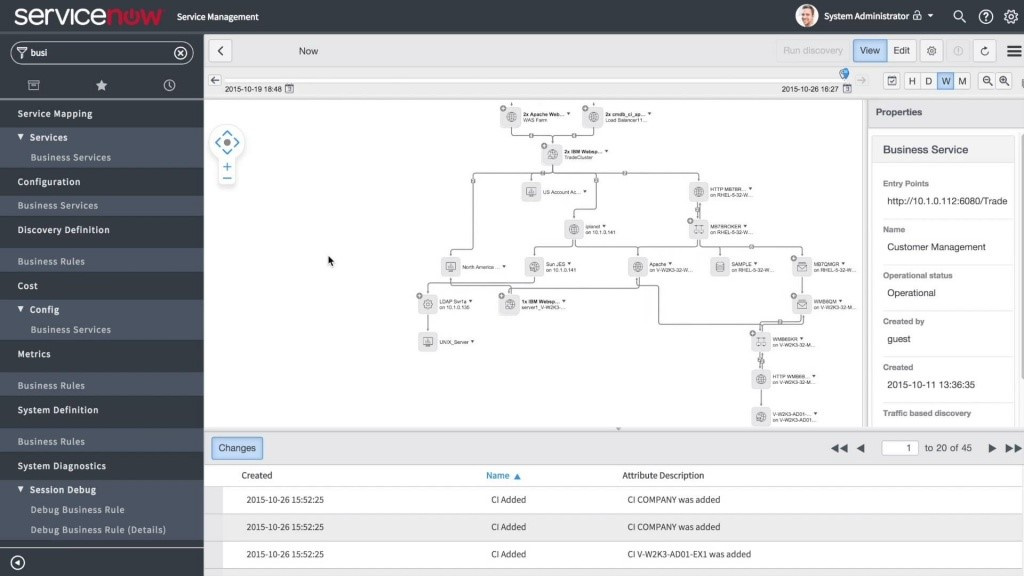How to implement configuration management processes
Proper implementation of configuration management processes allows not only to solve problems by identifying the cause of a “breakdown” (which element went down and how to fix it), but also to completely prevent their occurrence by evaluating the logic of working with data. Competent assessment of the changes made allows you to maintain the system in working condition, and incorrect - leads to a waste of money.
In addition to financial costs, improper configuration management leads to the expenditure of other resources, such as man-hours. Resources have to be spent on working with clients during troubleshooting with the IT infrastructure. It is difficult to manage change if the implementation of solutions is not supported by the CMS system. Therefore, today we will tell you about the implementation of configuration management processes and what aspects you should pay close attention to.
 Image of Kenny Louie CC
Image of Kenny Louie CC
')
Before you begin the implementation, it is necessary to explain the meaning of the CMS system to all participants in the ecosystem: team members, customers, etc. This is important because in the future each side will take part in configuration management - members of the CMS team must provide accurate information to their colleagues responsible for the incidents and changes, and actions taken by IT professionals should be displayed in the Configuration Management Database (CMDB).
For CM organizations, the well-known model of continuous improvement of PDCA processes is well suited. Following this model, the implementation of CMS can be divided into four parts: planning and determination, control, status accounting, audit.

Since the configuration management will be the basis for the provision of services and business processes of the company, then for its high-quality implementation you need to make a plan.
We recommend starting planning configuration management with the most critical business processes - handling incidents and problems. Technical support is always loaded with requests from users, so it is important to ensure their timely execution. The implementation of the project from this class of services will optimize the work of technical support, which will certainly affect the efficiency of other departments of the company.
When planning, it is also worthwhile to pay attention to critical services and services that are necessary for management in order to lay a foothold for future scaling (which depends on the company's growth rate and the range of services provided).
The stage of determining the initial state is the next step after planning, which is needed in order to understand what elements the company's infrastructure consists of at the moment. Such a snapshot in the future can be used to compare conditions, for example, "this year the volume of property increased by 20%, which led to the emergence of 2 thousand new changes."
Once the initial state is determined, you should make sure that it complies with service level agreements (SLAs), operational agreements (OLAs), external agreements (UCs) related to the IT infrastructure and services of the organization.
The definition of the initial state should start with any one service, by painting all its components. At the same time, the obtained information must be entered into the database of the ITSM platform, for example, ServiceNow, or a simple CMDB database - this can be a table in Excel or Access.

As for the ServiceNow platform, it provides convenient tools for creating and maintaining a configuration management system. The user has access to two hundred types of configuration items, such as computers, laptops, servers, office equipment, software, Internet resources, etc. ServiceNow Discovery, which automatically scans the network and adds the found units, imports the CMDB database.

Also note that it is important to determine the person responsible for entering information into the database.
The next step in implementing configuration management is change control — a process that should be applied to all actions performed on IT infrastructure objects. For the successful implementation of control, you must comply with a number of basic requirements:
The next step is to take into account the state that is needed to track the life cycle of all configuration units (CI) - “building blocks”, which include servers, routers, software and all the systems on which it is built - and their current state. CI lifecycle statuses must be defined in the CMS policy to ensure consistency and documentary evidence of all the stages through which the configuration unit passes. Among these stages, the following are distinguished: scheduled, priority increased, delivered, test environment, working environment, not used, deleted.
The final stage of CMS implementation is called verification and audit. Its task is to ensure the accuracy of the data presented in the CMDB: all working CIs should correspond to what is stated in the CMS / CMDB, and the support documentation should accurately describe all CIs. In order to meet these requirements, it is important to draw up and approve a test plan containing the answers to the following questions:
All companies are different, but the general trend is that the audit of critical services is carried out once a month. A full internal audit is conducted annually. For this purpose, a check log is created, in which all violations identified during the audit, as well as those responsible for their elimination will be entered. Information such as the inspection date, CI with violations, the responsible manager, elimination requirements, the contractor, and the deadline and status of the task are recorded in the journal.
At the same time, various ITSM-systems (including ServiceNow) allow auditing to be performed automatically, using special dashboards, which translate a huge amount of information into a form that the user can understand.
In conclusion, I would like to note that configuration management is only one of the aspects of the effective use of the IT infrastructure and the high-quality service delivery. If you add to it processes such as asset management and capacity management, then you get a comprehensive model of flexible and rational use of all the resources at your disposal. We plan to talk about them in our following materials.
PS Other materials from our blog "IT Guild":
PPS And a couple of materials from our blog on Habré:
In addition to financial costs, improper configuration management leads to the expenditure of other resources, such as man-hours. Resources have to be spent on working with clients during troubleshooting with the IT infrastructure. It is difficult to manage change if the implementation of solutions is not supported by the CMS system. Therefore, today we will tell you about the implementation of configuration management processes and what aspects you should pay close attention to.
 Image of Kenny Louie CC
Image of Kenny Louie CC')
Where to begin
Before you begin the implementation, it is necessary to explain the meaning of the CMS system to all participants in the ecosystem: team members, customers, etc. This is important because in the future each side will take part in configuration management - members of the CMS team must provide accurate information to their colleagues responsible for the incidents and changes, and actions taken by IT professionals should be displayed in the Configuration Management Database (CMDB).
For CM organizations, the well-known model of continuous improvement of PDCA processes is well suited. Following this model, the implementation of CMS can be divided into four parts: planning and determination, control, status accounting, audit.

Since the configuration management will be the basis for the provision of services and business processes of the company, then for its high-quality implementation you need to make a plan.
Planning
We recommend starting planning configuration management with the most critical business processes - handling incidents and problems. Technical support is always loaded with requests from users, so it is important to ensure their timely execution. The implementation of the project from this class of services will optimize the work of technical support, which will certainly affect the efficiency of other departments of the company.
When planning, it is also worthwhile to pay attention to critical services and services that are necessary for management in order to lay a foothold for future scaling (which depends on the company's growth rate and the range of services provided).
Determining the initial state
The stage of determining the initial state is the next step after planning, which is needed in order to understand what elements the company's infrastructure consists of at the moment. Such a snapshot in the future can be used to compare conditions, for example, "this year the volume of property increased by 20%, which led to the emergence of 2 thousand new changes."
Once the initial state is determined, you should make sure that it complies with service level agreements (SLAs), operational agreements (OLAs), external agreements (UCs) related to the IT infrastructure and services of the organization.
The definition of the initial state should start with any one service, by painting all its components. At the same time, the obtained information must be entered into the database of the ITSM platform, for example, ServiceNow, or a simple CMDB database - this can be a table in Excel or Access.

As for the ServiceNow platform, it provides convenient tools for creating and maintaining a configuration management system. The user has access to two hundred types of configuration items, such as computers, laptops, servers, office equipment, software, Internet resources, etc. ServiceNow Discovery, which automatically scans the network and adds the found units, imports the CMDB database.

Also note that it is important to determine the person responsible for entering information into the database.
Control
The next step in implementing configuration management is change control — a process that should be applied to all actions performed on IT infrastructure objects. For the successful implementation of control, you must comply with a number of basic requirements:
- Work closely with change control workers so that the configuration management job follows corporate change policies. Without change control, CMS / CMDB will quickly become obsolete.
- Configuration units involved in the service provision process must be associated with it. This will allow the user to quickly select the desired service. In this case, all CIs will be added automatically.
- IT professionals responsible for the configuration management system should participate in the Change Advisory Councils (CABs) to display changes made to the infrastructure in the CMS and CMDB. In this case, all changes must be checked before closing the ticket as successful.
State accounting
The next step is to take into account the state that is needed to track the life cycle of all configuration units (CI) - “building blocks”, which include servers, routers, software and all the systems on which it is built - and their current state. CI lifecycle statuses must be defined in the CMS policy to ensure consistency and documentary evidence of all the stages through which the configuration unit passes. Among these stages, the following are distinguished: scheduled, priority increased, delivered, test environment, working environment, not used, deleted.
Audit
The final stage of CMS implementation is called verification and audit. Its task is to ensure the accuracy of the data presented in the CMDB: all working CIs should correspond to what is stated in the CMS / CMDB, and the support documentation should accurately describe all CIs. In order to meet these requirements, it is important to draw up and approve a test plan containing the answers to the following questions:
- Are there special inspection tools?
- Is a physical check required?
- What are the regulatory requirements?
- Is there ISO 20000 certification and should IL3, BASEL 3 or NGN224 be performed requiring third party intervention?
All companies are different, but the general trend is that the audit of critical services is carried out once a month. A full internal audit is conducted annually. For this purpose, a check log is created, in which all violations identified during the audit, as well as those responsible for their elimination will be entered. Information such as the inspection date, CI with violations, the responsible manager, elimination requirements, the contractor, and the deadline and status of the task are recorded in the journal.
At the same time, various ITSM-systems (including ServiceNow) allow auditing to be performed automatically, using special dashboards, which translate a huge amount of information into a form that the user can understand.
In conclusion, I would like to note that configuration management is only one of the aspects of the effective use of the IT infrastructure and the high-quality service delivery. If you add to it processes such as asset management and capacity management, then you get a comprehensive model of flexible and rational use of all the resources at your disposal. We plan to talk about them in our following materials.
PS Other materials from our blog "IT Guild":
- Interview with ServiceNow CTO about IT innovations, priorities and development
- How to make ITIL more customer-oriented
- Financial Management - budgeting and cost estimation for the services provided in ServiceNow
- 4 myths about managing services that you shouldn’t believe
- Top Free Resources for ServiceNow Specialist
PPS And a couple of materials from our blog on Habré:
Source: https://habr.com/ru/post/331374/
All Articles